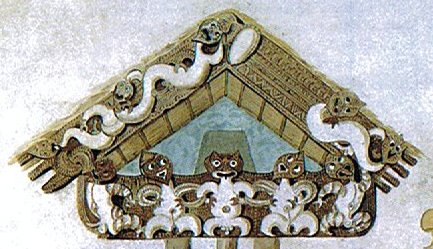 |
 |
 |
 |
 |
| Ea9-25 |
Ea9-26 |
Ea9-27 |
Ea9-28 |
Ea9-29
(319) |
326 - 36 = 290 is the number of glyphs from Ea1-1 to the end of
line Ea8. Adding 29 to 290 results in 319 at hura in
Ea9-29, a day of Mercury, where significantly 9 and 29 are
numbers 'without light' (the feeble 'son of Sun' having like
Phaethon carelessly raced the 'sun-chariot' down into the
sea).
This important point
in the text forces us to also count 92 * 9 = 828 = 2 * 414,
maybe implying that 828 is to be understood as 826 + 2 = 2 *
(413 + 1), based on a fundamental cycle of 14 * 29.5 = 413
nights.
From this I imagine
hura in Ea9-29 could refer to a pair of 'one more', like a
pair of interconnected eggs. The top one is circular in form but
the bottom one is slightly oval (like a drop). This pair of
'eggs' possibly represents the 2 cycles of the year, one for the
front side (high up like midsummer sun) and one for the back
side (the low 'drop'). Of course I have been influenced by the
Taranaki storhouse (though it has only one egg):

What happens with
these interconnected 'eggs'? They seem to go down into the
'earth', become 'hilled up', we can read from puo in
Ea9-30:
 |
 |
 |
 |
 |
 |
 |
|
Ea9-30 (320) |
Ea9-31 |
Ea9-32 |
Ea9-33 |
Ea9-34 |
Ea9-35 |
Ea9-36 (326) |
After that 'the visibility' (eyes are formed like eggs)
cannot be as before for a while (cfr the empty space to the
right of the egg in the picture above).
But in Ea9-33 we can see a whole fish. 93 * 3 = 279 = 31 * 9
which connects it with hura in Ea9-29 (with ordinal
number 319). The preceding Saturn glyph holds another complete
fish in front, and 8 * 36 = 288 is equal to 9 * 32. Presumably
we should, however, rather count 93 * 2 = 186 (= 366 - 180). The
2 fishes are leaning slightly away from each other, a sign which
should indicate end (looking back) respectively new beginning
(looking forward):
 |
 |
 |
|
Ea9-30 |
Ea9-31 |
Ea9-32
(322) |
 |
 |
 |
 |
|
Ea9-33 |
Ea9-34 |
Ea9-35 |
Ea9-36 (326) |
If this is a correct interpretation then we should regard the 4
glyphs Ea9-33--36 as the beginning of the next cycle, and 4 +
302 = 306 = 17 * 18. More interesting, though, is the possible
reading 30 * 6 = 180 = 366 - 93 * 2.
We turn the tablet and continue to read on side b. It begins
with a glyph similar to that in Ca1-26, but the 'head' in Eb1-1
is in a high position (like
maitaki in Eb1-7) and it has no 'eye' at left. Maybe the
left 'eye' has been 'hilled up', which also could explain the
high positions of Eb1-1 and Eb1-7):
 |
 |
 |
 |
 |
 |
 |
 |
 |
|
Ca1-26 |
Eb1-1
|
Eb1-2 |
Eb1-3 |
Eb1-4 |
Eb1-5 |
Eb1-6 |
Eb1-7 |
Eb1-8 |
The beginning of the front side of Mamari exhibits glyphs
which resemble what we have read at the end of side a of
Keiti:
 |
 |
 |
 |
 |
 |
|
Ca1-1 |
Ca1-2 |
Ca1-3 |
Ca1-4 |
Ca1-5 |
Ca1-6 |
 |
 |
 |
 |
 |
 |
 |
| Ea9-25 |
Ea9-26 |
Ea9-27 |
Ea9-28 |
Ea9-29
(319) |
Ea9-30 (320) |
Ea9-31 |
The
'melody' is the same but the 'song text' is different. For instance
is henua ora in Ea9-27 narrow and straight while henua ora
in Ca1-3 is broad and curved (a sign of the expansion, horahora,
inherent in spring). The same contrasting signs characterize the
following hau tea
glyphs.
In Ea9-25 an empty hand is the major sign, which probably
indicates the 'fire' in the sky (Spring Sun) is 'finished'. In
Ca1-1 we instead can see ragi (the night sky) without any
sign of the light from Moon. Moon has 2 'faces' and there are 2
irregular 'balls' hanging down in front in Ca1-3. The sign
between henua ora
and these 'hanging balls' is an odd variant of haga rave
- also Venus has her 'harbours', I think.
Metoro said
haga i te mea ke at Saturday in Ca1-4, just as he did
at
hura in Ca5-14 (kua haga te mea ke), which
'proves' that he was able to understand at least some parts of
the Mamari text:
 |
 |
 |
 |
 |
|
Ca5-12 |
Ca5-13 |
Ca5-14 |
Ca5-15 |
Ca5-16 |
This is also the place to mention the strange behaviour of
Metoro when he began to read backwards on side b of Keiti.
For this we need an extra page.